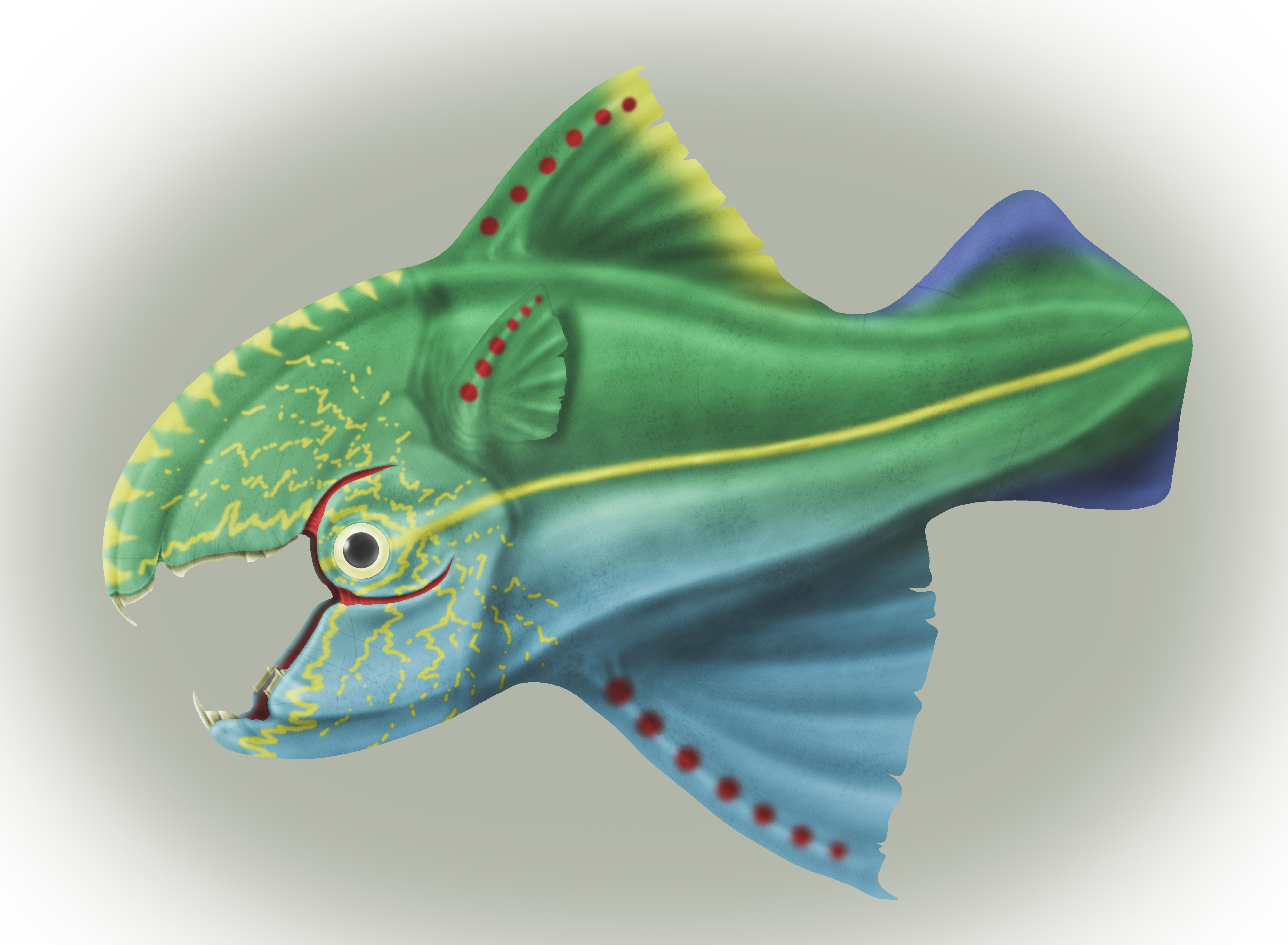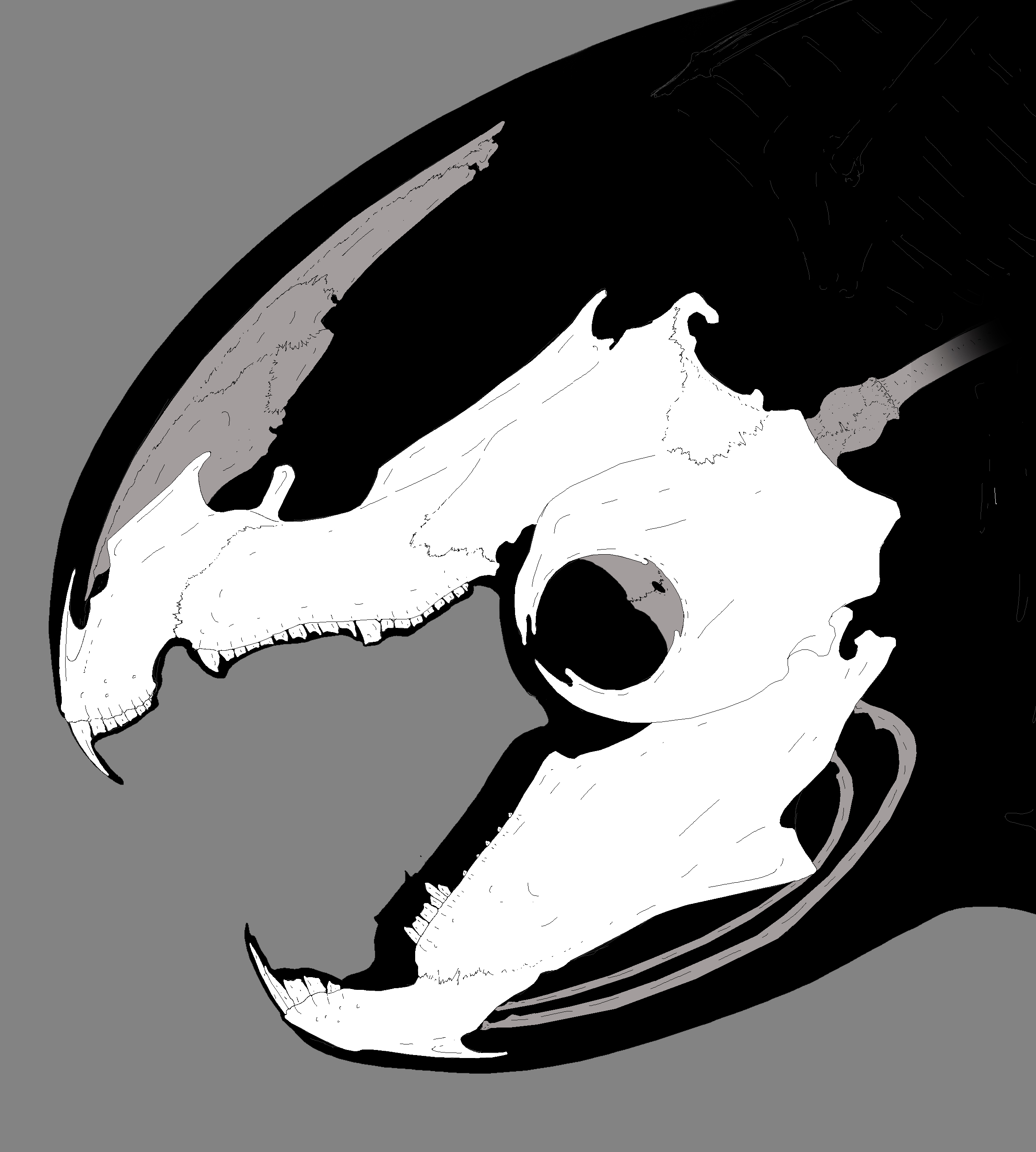Chalybomaxillae fulmineus
Chalybomaxillae fulmineus is a large Titanid Hijerakid amphibian from the crest reefs of the Gulf Sea.
Perhaps most famous for its gigantic head to body ratio, the animal evolved specifically to feed on the shelled plants making up the reefs it inhabits, acting as a major contributor in the bioerosion processes of the area.
Sometimes called the "Sandmaker", the animal grinds up the plants it feeds upon, finely crushing the plant's armour into sand-sized particles through the sphaera lania, once the softer plant material is digested and absorbed, the animal will excrete from the rectum a cloud of white sand, the remains of the plant's armour, that will deposit on the seafloor and act as sediment that will help the reef grow further.
The gigantic head, skeleton-wise, is much smaller than what it seems, with plenty of the visible area is tightly packed musculature made to crush even the hardest of the corals, the species he specialized in foraging.
Although the species is most common along the crest of the reef, where most massive corals grow, it is not uncommon to find young specimens deep into the inner reef, especially those that moved in with the high tide and remained blocked inside once it retreated.
Beaching events of the species caused by human activities have become, especially in the last century, almost a yearly occurrence; motorboats and other anthropic activities such as uneducated divers disturb the animal's natural habitat, driving them away and, oftentimes, in the open sea where they become confused and end up beaching km away from their place of origin.
Unfortunately, the tourism industry profits from the intense bathing activity and water sports, leading local governments to opt against the reduction of these activities in favour of a more eco-friendly approach.
Basic Information
Anatomy
- Head very large and rounded, as big as roughly one third of the entire body.
- Eye central to the head, right beside the mouth.
- Teeth fused into very strong and sharp plates, incisors especially long.
- Pectoral fin small and leaf shaped, moved dorsally compared to the body, above the upper ribcage.
- Dorsal and Anal fins veiled, growing from the base of the body and running down the Gill Tail.
- Gill Fan high and short with high ridges terminating abruptly into a very steep caudal drop.
Genetics and Reproduction
Seasonally monogamous species.
C. fulmineus mates in the summer.
Females of the species enter heat before males, brightening her patterning and increasing in size due to the seasonal hormonal changes; during these months, in particular, females can become much more aggressive towards humans or other animals of the reef, especially if she doesn't find a mate as the hormonal levels can be as high as 3.000% over the average for an out of breeding season specimen.
Females in heat will prowl the reef crest in search of a possible mate; once they spot a male, they'll start circling the animal, showing off the bright patterning and pushing it around not so lightly, she won't leave the male's sight until either he flees or accepts her advances.
Very frustrated females have been observed attacking other same-gender conspecifics already coupled, trying to bite and ram them against the rocky reef, sometimes attacking other animals or even boats, making easy work of any small motorboat it gets its jaws on.
Although attacks are very rare, during the breeding season it is always advised to keep close to the shore as a safety warning.
Mating can take hours to complete and after the female has been fertilized, she'll calm down and start foraging again normally.
The female incubates the eggs in the duct for three to five months before giving birth to one to three live young.
The couple will separate as soon as the young are born and the male will take care of them until the next breeding season, as by then any female in heat would probably attack and kill the young.
Growth Rate & Stages
Ontogenesis in the species not too marked, young specimens will have the teeth unfused in smaller plates and the head less rounded due to the muscles not yet being fully developed.
Natal aculeus very reduced at birth, absorbed shortly after.
Ecology and Habitats
Epipelagic animal found at depths ranging from 5 and 30 m.
They live along the outer side of the Reef crest, where most massive corals grow.
Dietary Needs and Habits
Herbivorous species feeding off of corals and Proto-sponges.
Biological Cycle
Periannial creature with few dips in activity year long.
During the mating season females enter a hyperaggressive state and, although rarely, attack motorboats.
Additional Information
Social Structure
Female lonesome outside of the breeding season; males often carry the young with them.
Although not very social, it tolerates the presence of conspecifics and communicates with them through sound.
Domestication
Seen in some public aquariums in two story tanks with plenty of space for it to roam around.
Doesn't reproduce in captivity.
Uses, Products & Exploitation
No major uses for the animals outside of some ecoturistic activities.
Otherwise quite inconvenient to seaside activities.
Perception and Sensory Capabilities
average sight, excellent hearing.
Symbiotic and Parasitic organisms
Afflicted by Intestinal Tube Worms and drinker worms.
In a mutualistic relationship with smaller amphibians and cnidarovertebrates that clean its skin from parasites.
Scientific Name
Eoichthyia; Hijerakia; Bathymonsteroidea ; Titanidae; Chalybomaxillae; C. fulmineus
Lifespan
130 Years
Conservation Status
Endangered to locally Extinct: frequent bathing activity and water sports lead to mass beachings yearly; no action has been taken to protect the species yet.
Population Trend: DECLINE
Average Weight
1.5-4 tons
Body Tint, Colouring and Marking
Green body with azure-blue countershading, slightly lighter on the head.
Yellow patterning over the head and in a single band over the length of the body, single yellow stripe along the border of the dorsal fin.
Red dots over the length of the arms.
Darker blue ridges of the fan.
Remove these ads. Join the Worldbuilders Guild













What a beautiful creature :D Fantastic Job